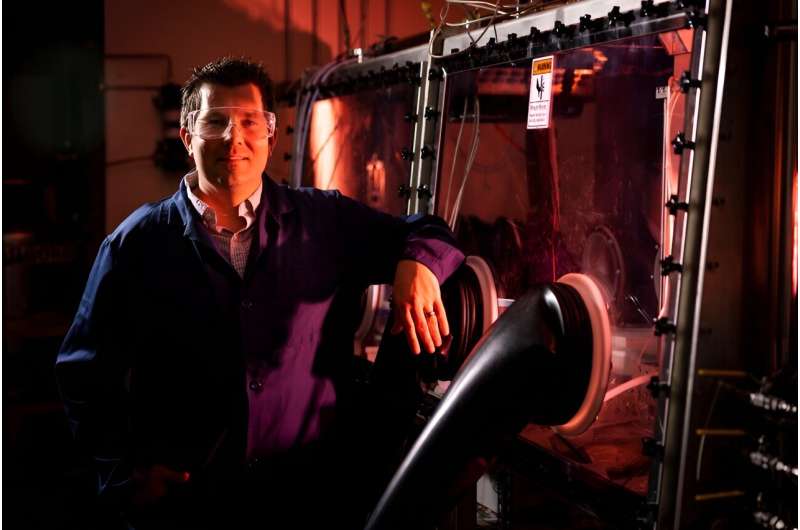This article has been reviewed according to Science X's editorial process and policies. Editors have highlighted the following attributes while ensuring the content's credibility:
fact-checked
trusted source
proofread
Engineering research finds key to quicker nuclear power: Artificial intelligence

A Brigham Young University professor has figured out a way to shave critical years off the complicated design and licensing processes for modern nuclear reactors: artificial intelligence.
You heard that right, AI is teaming up with nuclear power. And while that may seem like a worrisome bit straight out of a science fiction movie, chemical engineering professor Matt Memmott says it's not what it sounds like; no one is giving AI the nuclear codes. It's all about speeding up the process to get more nuclear power online.
The typical time frame and cost to license a new nuclear reactor design in the United States is roughly 20 years and $1 billion. To then build that reactor requires an additional five years and between $5 and $30 billion. By using AI in the time-consuming computational design process, Memmott estimates a decade or more could be cut off the overall timeline, saving millions and millions of dollars in the process—which should prove critical given the nation's looming energy needs.
"Our demand for electricity is going to skyrocket in years to come and we need to figure out how to produce additional power quickly," Memmott said.
"The only baseload power we can make in the Gigawatt quantities needed that is completely emissions free is nuclear power. Being able to reduce the time and cost to produce and license nuclear reactors will make that power cheaper and a more viable option for environmentally friendly power to meet the future demand."
Designing and building a nuclear reactor is so complex and time-consuming because it requires multi-scale efforts, according to Memmott. Engineers deal with elements from neutrons on the quantum scale all the way up to coolant flow and heat transfer on the macro scale.
He also said there are multiple layers of physics that are "tightly coupled" in that process: the movement of neutrons is tightly coupled to the heat transfer which is tightly coupled to materials which is tightly coupled to the corrosion which is coupled to the coolant flow.
"A lot of these reactor design problems are so massive and involve so much data that it takes months of teams of people working together to resolve the issues," he said.
"When I was at Westinghouse it took the team of neutron guys six months just to run one of their complete-core multi-physics models. And if they made a mistake two months in, then they just wasted two months of the valuable computational time and they would have to start over."
Memmott's is finding AI can reduce that heavy time burden and lead to more power production to not only meet rising demands, but to also keep power costs down for general consumers. In recent years, homeowners and renters nationwide have already felt the sting of rising utility costs.
Technically speaking, Memmott's research proves the concept of replacing a portion of the required thermal hydraulic and neutronics simulations with a trained machine learning model to predict temperature profiles based on geometric reactor parameters that are variable, and then optimizing those parameters.
The result would create an optimal nuclear reactor design at a fraction of the computational expense required by traditional design methods.
For his research, he and BYU colleagues built a dozen machine learning algorithms to examine their ability to process the simulated data needed in designing a reactor.
They identified the top three algorithms, then refined the parameters until they found one that worked really well and could handle a preliminary data set as a proof of concept. It worked (and they published a paper on it) so they took the model and (for a second paper) put it to the test on a very difficult nuclear design problem: optimal nuclear shield design.
The resulting papers, published in Nuclear Engineering and Design, showed that their refined model can geometrically optimize the design elements much faster than the traditional method. For example, it took Memmott's AI algorithm just two days to come up with an optimal shield design for a nuclear reactor, while local molten salt reactor company, Alpha Tech Research Corp., took six months to do the same.
"When you look at nuclear reactor design, you have this huge design space of possibilities—it's as if you have people combing through this mile-wide area looking for the right reactor design," Memmott said.
"Now AI can help those people focus on that little quarter-sized sweet spot of design which will drastically reduce the search time. Of course, humans still ultimately make the final design decisions and carry out all the safety assessments, but it saves a significant amount of time at the front end."
More information: Andrew Larsen et al, Optimization of passive modular molten salt microreactor geometric perturbations using machine learning, Nuclear Engineering and Design (2024). DOI: 10.1016/j.nucengdes.2024.113307
Andrew Larsen et al, Multi-objective optimization of molten salt microreactor shielding perturbations employing machine learning, Nuclear Engineering and Design (2024). DOI: 10.1016/j.nucengdes.2024.113372


















